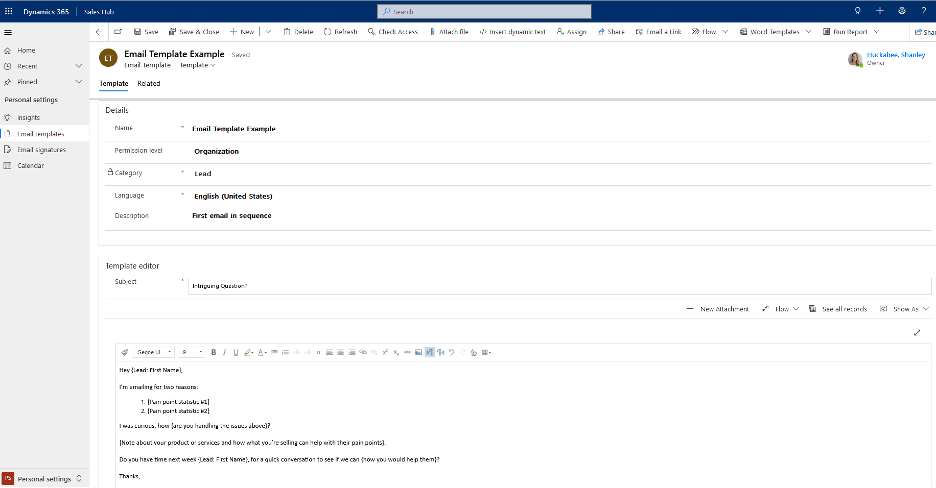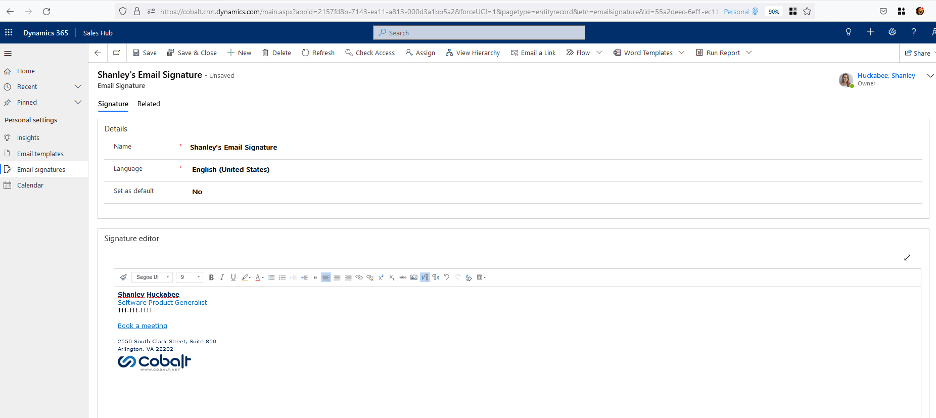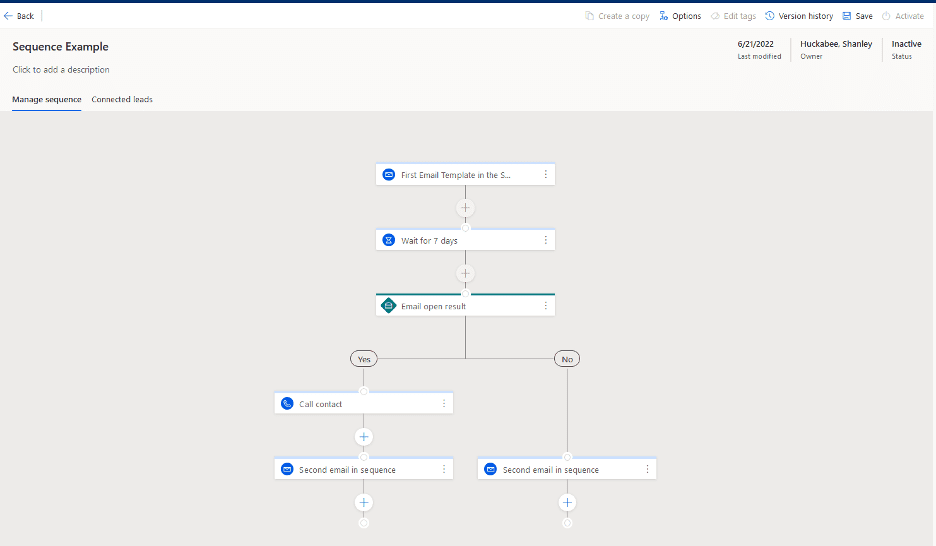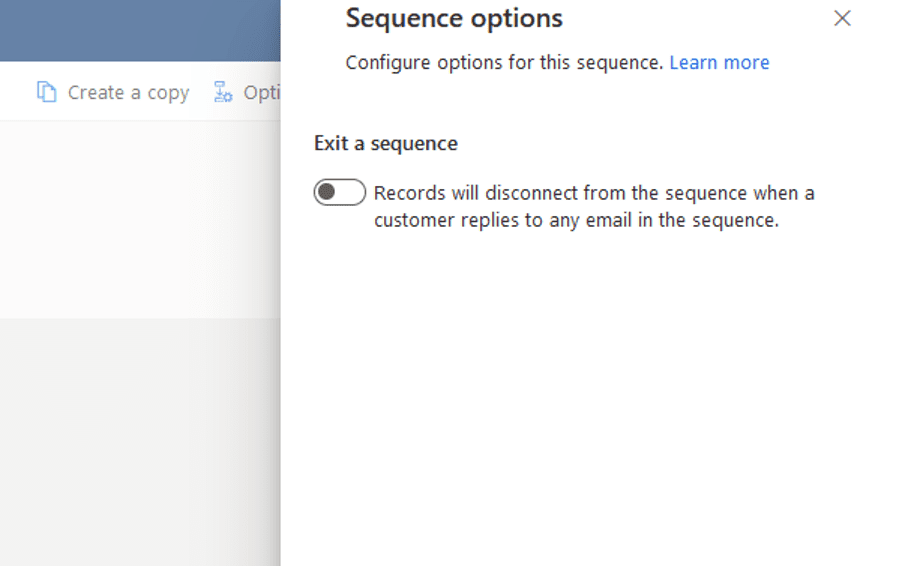Stronger, more creative sales email templates are one of the best ways to keep your sales outreach fresh and effective. Putting the right personalized email messages together with an adaptable email sequence template is harder, but just as essential. Our team at Cobalt has assembled the best of both for you today: our best sales email templates with an email sequence template that you can easily adapt for your business and industry.
Our team at Cobalt uses all of the sales email template examples you will find below. We know they work because we keep crushing our own sales goals and outreach efforts. We sell customer resource management (CRM) software solutions, but these examples and our sales email sequence template are adaptable for virtually any industry.
If you happen to be part of a sales team for a technology company, don’t miss some related content.
Tested Lead Generation Strategies for Technology Companies: 4 Strategies
LinkedIn Sales Navigator & Dynamics 365 Sales Integration
Sales Cadence for B2B Success
And, of course, no matter what size sales team you have or industry you serve, if you’re looking for a CRM or sales and marketing automation software your sellers will actually like and use: let us show you what Microsoft Dynamics 365 Sales can do.
Cobalt’s Ideal Sales Email Templates and Sales Email Sequence (6 Emails)
Here’s exactly how we structure some of our sales outreach with email templates and an email sequence that is flexible enough for almost any organization.
Email #1: The Cold Email
As with all of the sales email templates we have included in our ideal email sequence, it’s important to keep the cold email clear, direct, and free of fluff. If this is someone’s first look at your company and connection with you, this is where you prove to them that there’s a good reason to hear more.
Here is one way you could structure that first message to your prospects.
Hey {Lead: First Name},
I’m emailing for two reasons:
- {Pain point statistic #1}
- {Pain point statistic #2}
I am curious, how {are you handling the issues above}?
{Note about your product or services and how what you’re selling can help with their pain points}.
{Lead: First Name}, do you have time next week for a quick conversation to see if we can {a specific way you would help them}?
Thanks,
{Custom Email Signature}
How We Use It
Our team at Cobalt will often use a variation on this cold email template in our initial outreach to new prospects. A large part of our business is selling CRM software to sales and marketing teams that really don’t like their current CRM or sale support software. This cold email helps us briefly let the recipient understand that we get some of their core, high-level challenges and that we know we can offer something that will help.
Why It Works
Specificity is crucial. Those leading pain point statistics not only grab attention, but they also help with our credibility. Following up with a real question invites the reader to reflect on how those challenges are playing out in their day-to-day. The call to action (CTA) is clear, straightforward, and once again, specific. If you can briefly boil down exactly how taking that meeting with you will help them, you will see a stronger response rate.
Email #2: A Prospecting Email Variation
This variation on the cold email serves as another kind of opening for the sales conversation. Hopefully the recipient at least read your first email. But even if they did not, this email does some of the same work in a different way.
Hey {Lead: First Name},
Wouldn’t it be nice if {how your product/service can help the reader}?
{Light introduction to product/service selling point}.
{What the point above means for your business}.
Let’s chat next week to see if we can help drive performance across your organization.
Best,
{Custom Email Signature}
How We Use It
Busy sales team managers or sellers aren’t going to waste time on meetings with our sales team if we can’t make it clear up front that we really can help their team sell more, be more efficient, reduce admin headaches around their CRM, etc. This second email in our sequence is just another way of introducing ourselves and demonstrating that our CRM solutions meet real needs they have.
Why It Works
Maybe the prospect reading this email opened and read at least part of our first email. Maybe they were even curious about Cobalt or how we could help them, but they got distracted and didn’t check out our website or reach out directly to learn more about our software.
This email is effective because it immediately helps the reader envision a better way of working because a significant problem they have today has been resolved. The three micro points in this email form a straightforward chain: we get your vision for a better CRM and sales processes; our product is designed to meet specific needs/challenges like this one; this is the pay-off or impact on your bottom line you can expect if you move to Dynamics 365 Sales.
Email #3: First Sales Follow Up Message
Hi {Lead: First Name},
{Current customer quote about how your product/service solved a specific problem they had}. You can read their full testimony {here}.
Also, take a look at {link to your company blog or marketing materials}.
{Lead: First Name}, when would be a good time for us to chat about {specific way your product/service can help}?
Best,
{Custom Email Signature}
How We Use It
At this point in the email sequence, if we haven’t heard from a prospect after doing a solid, brief job of letting them know we get them and their world with some of its specific challenges, we send a version of this email. Some marketers refer to an email like this a social proof email. Even if we have heard back from a prospect with a general question but they still haven’t booked a product showcase with our team, this can be a helpful way of keeping Cobalt on their radar.
Why It Works
The social proof email can be compelling for cold prospects who don’t know you or your company well enough to feel confident in starting a serious sales conversation. The real key here is the same as it is with every other sales email you send: be real, and be really specific.
Consider current customers who have had a great experience with your team and whatever it is you sell. Even if they aren’t a brand champion for your company, it’s important that they be happy to speak about their problems before finding you — and how you helped them. That all boils down to a compelling, believable story that creates strong identification for hesitant prospects reading your email.
Build out a fuller case study or testimonial, but keep the snippet in this email brief. The very best distillation of that problem-solution story is what you’re looking for. It’s too tempting for most companies to just include a generic quote from a happy customer who says glowing, generic things about how great your company is. Part of the reason our version of the social proof email is so effective is because it avoids that trap and concentrates on real problems that were really solved.
Email #4: Second Sales Follow Up Message
Hey {Lead: First Name},
{Statistic about incorrect assumption(s) related to what you are selling}.
{Data and explanation myth-busting the quote above, in relation to your product}.
Checkout {link to more information on your service/product}.
When is the last time you evaluated {part of business affected by your product/service}? Let’s grab 30 minutes next week to get that conversation started.
Best,
{Custom Email Signature}
How We Use It
This email falls right in the heart of our ideal email sequence but the reality is that you could use this email before the social proof email and it would probably be just as effective. It gives us a legitimate reason to reach out again to a prospect who has not shown interest or has let an early conversation go cold because it provides something of value. Seasoned sales professionals likely already know a lot about CRM solutions, so they are genuinely surprised to learn that the price gap for licensing between three of the top CRM solutions (Pipedrive, HubSpot, and Dynamics 365) can be this wide.
Why It Works
There are two major reasons that this sales follow up email template works so well.
First, it offers something of true value to the reader: a helpful and insightful correction about their own industry, which they already know very well. That kind of moment can be dicey, so resist the temptation to be at all smug or condescending in the way you frame this part of the email. Here’s an outstanding example of an organization that is using data and reliable research to help correct misperceptions nearly all of us have around issues of global significance.
Second, it offers a different category of proof or credibility for prospects. Someone who might not find a testimonial quote compelling may well be persuaded by the right kind of statistic and a more data-driven, analytical approach.
It’s also worth mentioning that the CTA in this email is another example of making a simple, direct ask for a way to really start the conversation. As you’ll see in the next email in our sequence, we’re setting the stage for an even clearer request for a meeting.
Chaining your sales emails together with connections in the content like this helps give the entire sequence a feeling of continuity. It’s not a conversation (yet), but you can help avoid your messages coming off as completely disjointed with a little attention to how you start and end your emails.
Email #5: Final Follow Up Message Variation
Hey {Lead: First Name},
I know {recognition that changing business processes based on what you’re selling can be difficult} – and you’ve got to evaluate if it’s worth it. Well, let’s get that conversation started.
At {Organization}, we {what your organization does and how you can help}. The entire process can be done in as little as {timeline}.
Checkout our {what you offer} {on your website}.
Would you be interested in taking a look at {what you are selling}? One of my colleagues can help with a side-by-side comparison to your {current process}, and then even let you kick the tires on {some type of trial/test run}.
Thanks,
{Custom Email Signature}
How We Use It
This email is the clearest summary of everything we’ve said so far that we can offer lead prospects in our industry. You understand the reality of what it costs for sales teams to adopt a new CRM or migrate to a new sales support software platform. We use this email to reinforce the reality that we get it and that we can help them explore a relatively painless path to making a change that really will empower their sellers and managers — and win them more deals.
Why It Works
The strong note of continued identification up front sets the stage. But in reality, the strength of this email is the promise we’re making around timeline. There’s a solid chance that any prospect who is still reading our emails without committing to a product showcase by now sees the value in addressing their significant and/or long-standing challenges around business processes, trying to get their sales team to use a CRM they hate, etc. But how much effort, time, and money will it take to actually fix that problem?
This email is effective because it makes a clear statement about one of those key questions: the timeline for change. Even more than cost, the timeline for a CRM migration (and all the complications that could come with it) is often the top consideration or sticking point for our prospects.
So, we give them a realistic, compelling, specific sense of how long this project could take. Oftentimes, this is the tipping point for someone who has been on the verge of making a move to fix their CRM problems.
Email #6: The Breakup Email
Hi {Lead: First Name},
If now is not a good time to discuss upgrading {what you are selling}, that’s ok. I know we are all very busy these days.
However, if you would like to see how {you can help them via your product/service}, let me know. {Example testimonial of how your organization was able to help a different client}. Would it be worth a call to explore if we can do the same for {Lead: Company Name}?
Best,
{Custom Email Signature}
How We Use It
On the one hand, there’s not a lot to lose by the time you get to the breakup email in your email sequence. There are dozens of reasons that the sales teams we’re trying to reach may not have engaged our team in a serious conversation by this point. On the other hand, this is a great opportunity to generate some initiative for a meeting with our sellers.
Our aim here is to signal to prospects that we’re getting the message about our message, and that we’re going to give our team’s attention elsewhere — while leaving the door open for a future conversation.
Odds are good that you’ve read about how many touch points it can take to close a sale or see a viable lead conversion. A big part of the point here is to press on past those initial emails that don’t get a response and give readers a clear sense (one more time) of the value for getting in touch.
Why It Works
Sometimes, the breakup email helps a reluctant, busy, ordistracted sales manager overcome a minor obstacle to reaching out. That’s ideal, and the most common positive response.
But the best breakup emails are a kind of crafted distillation of all the value propositions and reasons you’ve already outlined throughout your email sequence. The opening statement in ours provides both clarity about how our team sees this opportunity and creates another layer of identification by acknowledging the truth: the readers are busy, just like us.
The testimonial and the question in the last paragraph are the real keys to success here, though. The right story of another client with a similar problem and success could land very, very well, at this point. And the direct question about if it’s worth just exploring what our team can do for them is direct and concise. As a matter of fact, this is often the email in our ideal sequence with the shortest word count. Get rid of everything that isn’t essential, and you’ll be in the best position.
How to Implement Our Sales Email Templates & Sales Email Sequence
You’ve taken winning sales email templates and invested all the time to write thoughtful, crafted messages and ordered them into an ideal sales email sequence. Now what?
If you are new to sale automation software, the implementation process in your CRM can be daunting. Building sequences, workflows, enrolling contacts, assigning sales reps, sorting out reporting: it’s a lot. And the process is different from system to system. Let’s take a look at how we would set up a new sales email sequence in Dynamics 365 Sales, using our ideal sales email templates.
First, we create email template records in Microsoft Dynamics 365 Sales to plug into our sequence. In D365 Sales, email templates allow you to dynamically pull in lead information like the lead’s name and email address.

Next, we configure custom email signatures. Everyone on our team can personalize their own email signature and even link content from our website or scheduling platform.

Once our email templates and signatures are ready to go, we design our sequence and set our email templates. Sequences allow you to create different communication paths based on how email recipients interact with your emails. In this example, if a recipient opens our first email, we wait and then follow up with a second email and call them directly. If they do not open our first email, we just follow up with a second email.

Once we have designed our sequence branching, determined our communication cadence, and added all our email templates, we are ready to go live! There is also an option to turn on auto-disconnect when a recipient replies to your email – think of this as Microsoft’s OTB unsubscribe functionality.

Take a Deeper Look at Sales Email Templates and Sales Email Sequences
The overview we just outlined for implementing your adapted sales email templates and new sales email sequence in Dynamics 365 Sales is only scratching the surface of what D365 can do for sales teams.
Cobalt’s YouTube channel has some really helpful videos that breakdown other tools and key features of both Dynamics 365 Sales and Dynamics 365 Marketing.
If you subscribe to Cobalt Insights, our monthly newsletter, we’ll send you articles like this one directly to your inbox each month with other actionable content for small and medium sized sales and marketing teams.
And if you really want to see what Dynamics 365 can do for your organization: schedule a product showcase with one of our specialists. In less than an hour, we can help you see exactly how your business processes and sales efforts could be more efficient and effective.
